Muistomerkit
Luumäellä sijaitsee yhteensä 17 muistomerkkiä, jotka kertovat historiasta aina 1700-luvulta viimeisten sotien aikoihin asti. Luumäen pääkirjastosta löytyy sotien aikaa käsittelevää kirjallisuutta, joka kytkeytyy Luumäkeen.
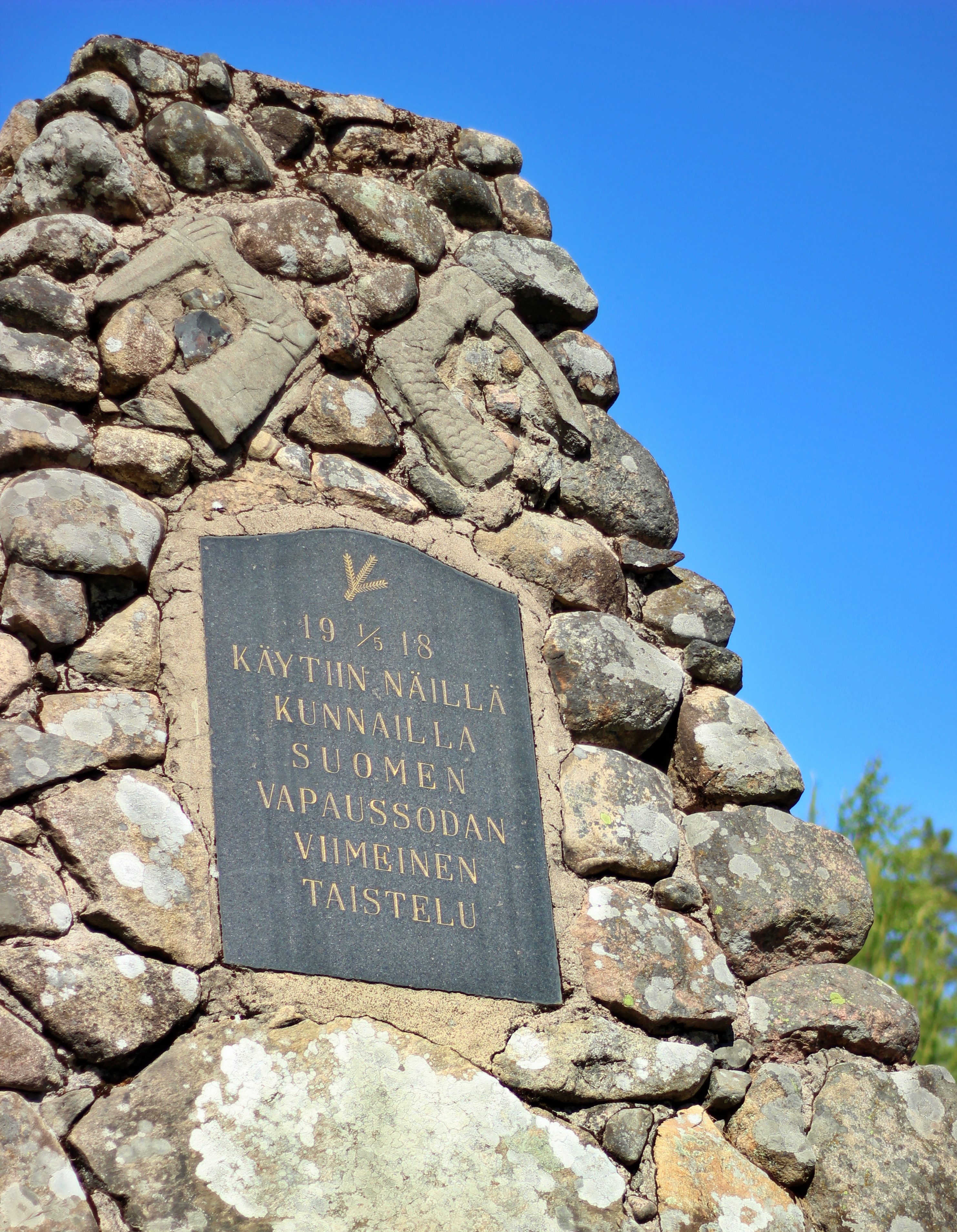
Suomen sisällissota eli vapaussota käytiin 27.1.–15.5.1918 heti Suomen itsenäistymisen jälkeen. Venäjällä tapahtuneet poliittiset muutokset, tsaarinvallan kaatuminen ja maailmansota mahdollistivat Suomen itsenäistymisen edellisen vuoden lopulla. Epävakaa tilanne aiheutti kuitenkin poliittisen ja sotilaallisen kriisin, joka johti sotaan tammikuussa 1918. Punaisten joukot hallitsivat Etelä-Suomea, valkoisten pohjoisempaa Suomea. Sodan ratkaisutaistelut käytiin maalis-huhtikuussa 1918. Tällöin valkoisten joukot valtasivat Etelä-Suomen isot kaupungit yhdessä saksalaisten kanssa. Sota vaati yli 37 000 ihmishenkeä, joista vain osa kuoli rintamalla, osa kuoli muissa väkivaltaisuuksissa ja osa vankileireillä.
Luumäellä kerrotaan käydyn vapaussodan ensimmäisiin ja viimeisiin kuuluneet taistelut. Ensimmäinen kahakka käytiin ennen sisällissodan varsinaista käynnistymistä jo tammikuun 21. päivänä. Luumäen valkoiset olivat muutamaa päivää aiemmin kaapanneet punaisten asekuljetuksen ja saaneet saaliiksi noin 70 kivääriä ja 10 000 patruuna. Lappeenrannasta lähti yli kahdensadan miehen punakaarti junalla Taavettiin hankkimaan aseita takaisin. Syntyneissä kahakoissa kuoli yksi henkilö molemmin puolin laukausten vaihdossa. Tilanne päättyi punaisten vetäytymiseen, kun huhu tuhansien valkoisten lähestymisestä kantautui punaisten korviin. Valkoisten kaatunut oli jääkäri Lauri Pelkonen ja hänelle on pystytetty muistomerkki Marttilantien varteen tapahtumapaikalle.
Helmikuun puoleen väliin mennessä oli koko pitäjä punaisten vallassa. Heidän päätehtävä oli junaradan liikenteen turvaaminen ja alue pysyi tärkeänä rintamantakaisena huoltoalueena. Satunnaisia kahakoita syntyi, kun rintamalle valkoisten puolelle menijät kulkivat Luumäen läpi tai rautatiekuljetuksia yritettiin sabotoida. Vasta huhtikuussa tilanne muuttui, kun valkoisten hyökkäys kohti Viipuria alkoi.
Vapaussodan viimeisiin kuulunut tai stelu käytiin valkoisten ja punaisten välillä Kiurulan kankaalla 1. toukokuuta 1918. Viipurin valtauksen alkaessa olivat punaisten rintamat jo osin hajallaan ja he lähtivät Etelä-Karjalan länsiosassa perääntymään kohti Kymenlaaksoa. Pulsan aseman menetys sai punaiset luopumaan Luumäen asemasta ja siirtymään länteen kirkon seutuville. Taistelut jäivät hetkeksi paikalleen. Valkoisten tykit ampuivat Kangasvarren nuoriseuran talolta ja punaiset kirkonmäen suunnalta kahden päivän ajan, kunnes punaisten tykkiasemien sijainti paljastui ja tilanne ratkesi punaisten peräytymiseen. Kahakointi jatkui vielä Taavetin suunnalle seuraavana päivänä.
Viimeisen taistelun paikalle pystytti Luumäen suojeluskunta muistomerkin 1930-luvulla. Muistomerkki on aivan Itsenäisyydentien varrella Kiurulan kankaalla. Vapaussodan valkoisten hautamuistomerkki sijaitsee Luumäen kirkonmäellä. Vakaumuksensa vuoksi kuolleiden punaisten hautamuistomerkki on Taavetin hautausmaalla.
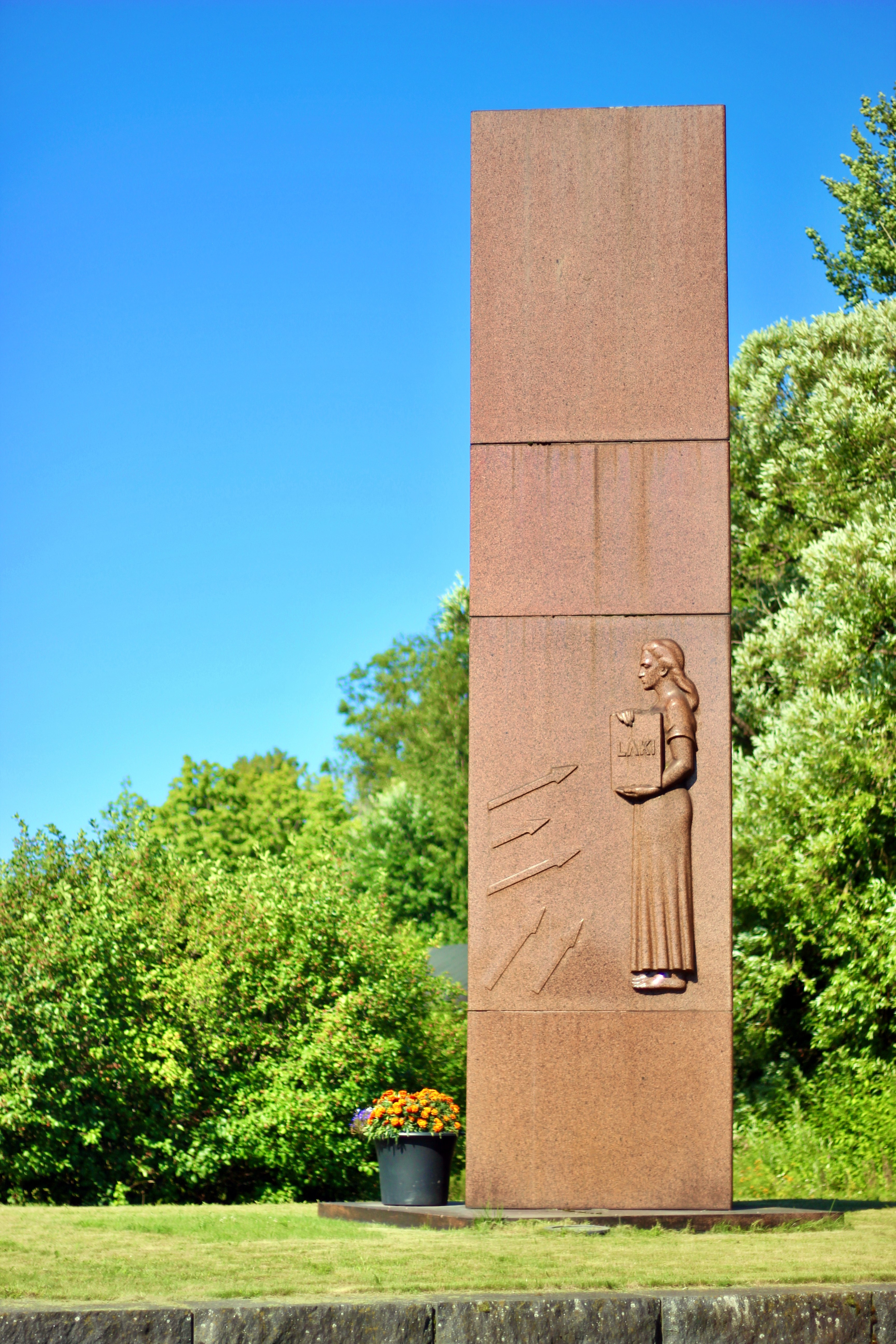
Graniittinen patsas on pystytetty Venäjän vallan ajan loppupuolella esiintynyttä sortoa vastaan käydyn oikeustaistelun merkiksi. Se ei ole tehty vain presidentti P.E. Svinhufvudin kokemien tapahtumien muistoksi vaan muistoksi koko Suomen kansan taistelulle oikeuden puolesta. Taistelu päättyi Suomen itsenäistymiseen 1917.
Aloite muistomerkin perustamisesta syntyi Luumäen Kotiseutu- ja Museoyhdistyksessä 1930-luvun puolivälissä. Alkuperäisenä ajatuksena oli kunnostaa Luumäen vanha käräjätalo, josta silloinen kihlakunnan tuomari P.E. Svinhufvud haettiin vallanpitäjän laittomiksi katsomilta käräjiltä. Hänet vangittiin ja vietiin karkotukseen pariksi vuodeksi Siperiaan marraskuussa 1914. Rakennuksen kunnostaminen ei kuitenkaan toteutunut, vaan päädyttiin patsaan hankintaan Luumäen asemalle.
Muistomerkin suunnittelusta järjestettiin suljettu kutsukilpailu kesällä 1937, jonka kuvanveistäjä Wäinö Aaltonen voitti kolmikulmaisen patsaan luonnoksella. Patsaan tekemiselle tuli kiire, sillä sen paljastustilaisuus oli tarkoitus olla itsenäisyyden 20. päivän aattona. Patsaan toteutti Kiviveistämö Oy Forsman Helsingistä yhdessä Wäinö Aaltosen kanssa. Toimitukseen sisältyi muistomerkin valmistus, perustukset ja pystytys. Patsas ehdittiin saada paikalleen juuri ennen juhlallisuuksia 30.11. Muistomerkki on 7 metriä korkea ja sen sivut ovat 1,5 metriä leveitä ja se on tehty Vehmaan punertavasta graniitista.
Muistomerkki paljastettiin juhlallisesti 5.12. Paikalle oli saapunut arvokas kutsuvieraiden joukko P.E. Svinhufvudin johdolla sekä pari tuhatta katsojaa. Paljastuksen jälkeen järjestettiin läheisellä Kangasvarren koululla juhlapäivälliset sekä iltajuhla nuorisoseurantalolla.
Muistomerkki ei ole alkuperäisellä paikallaan, vaan sitä siirrettiin vuonna 2009 neljätoista metriä ratapihan laajentumisen ja lisäraiteen rakentamisen takia. Vuonna 2017 valmistui uusi VT6:n linjaus ja muistomerkki on jäänyt rautatien ja valtatien väliin kapealle kaistaleelle asemarakennuksen itäpuolelle. Se näkyy vilaukselta tiellä liikkujille. Muistomerkille on kulku Itsenäisyydentien kautta. Jurvalan Salen kohdalta käännytään etelään Suoanttilan tielle ja ennen rautatietä on opasteet.
Muistomerkin sijainti Google Mapsissa.

Vuoden 2019 lokakuussa pystytettiin Hietamiehen kylään Jalkaväkirykmentti 16:n uusi muistomerkki kertomaan Luumäen alueella vuoden 1939 lopulla tehdyistä linnoitustöistä. Muistomerkin pystytti Pajarin Poikien Perinneyhdistys Ry yhdessä Luumäen kunnan ja muiden paikallisten toimijoiden kanssa. Muistomerkin yhteydessä on Leo Venäläisen tekemä puinen sotilasveistos sekä infotaulu. Paikalla on myös tilava parkkipaikka.
Jalkaväkirykmentti 16 perustettiin 13.–18.10.1939 Tampereella pääosin Pohjois-Hämeen reserviläisistä. Rykmentti kuului 6. Divisioonaan, joka sai tehtäväkseen ryhmittyä päämajan reserviksi Pulsa-Luumäki-Taavetti-Kaipiainen-Utti-alueelle. Rykementin komentajana toimi everstiluutnantti Aaro Pajari ja sen miesvahvuus oli noin 3000 sotilaista.
Perustamisen jälkeen rykmentti siirrettiin junakuljetuksin Taavetin asemalle. Täältä se majoittui aluksi rautatien eteläpuolelle Heimala-Luotola-Patolahti alueella. Lokakuun lopussa rykmentti siirtyi linnoitustöihin rautatien pohjoispuolelle Kivijärven ja Hietamiehen väliselle alueelle. Pääpaino linnoitustöillä oli panssariesteiden rakentamisella. Lisäksi rakennettiin asemat teiden kohdalle ja niihin konekiväärien asemia sekä ampumakuoppia ja taisteluhaudan pätkiä. Linnoitustöissä oli päivittäin noin kolmannes rykmentistä muiden ollessa erilaisissa koulutus- ja harjoitustapahtumissa.
Talvisodan sytyttyä rykmentti sai käskyn 5.12. siirtyä rautateitse Kaitjärven ja Taavetin asemilta Värtsilään ja sieltä edelleen marssien suoraan torjuntataisteluihin Osasto Talvelan osana Tolvajärvelle.
Muistomerkillä olevan päätaulun lisäksi kesäksi 2020 on tulossa maastoon linnoituskohteita esittelevät taulut ja ne muodostavat yhdessä Väliväylän uittoon liittyvien kohteiden kanssa noin 45 km reitin.

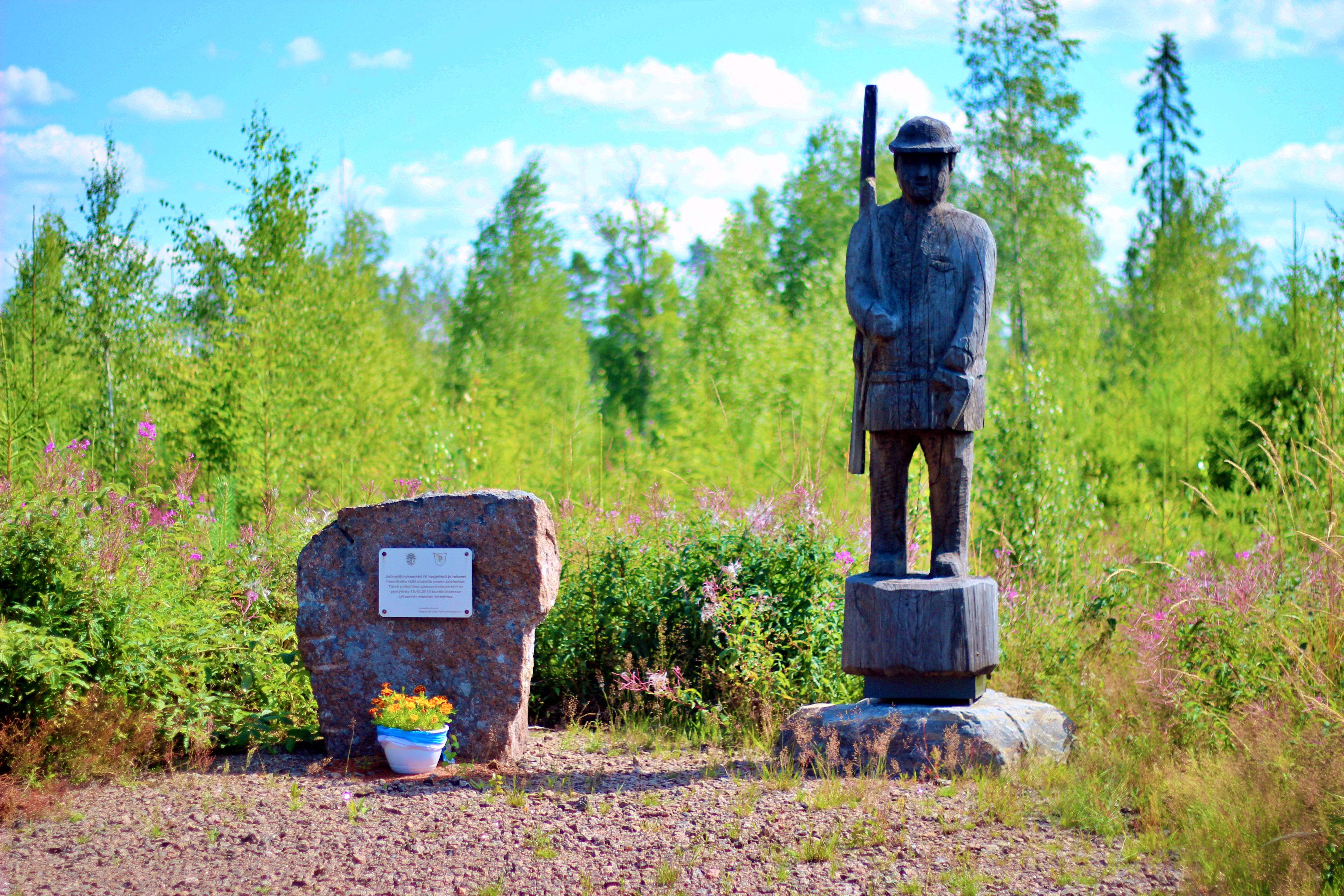
- Paikka maastokartalla/The place on a terrain map
- Google maps ajo-ohjeet/Google maps driving directions
Huopaisenvirta ja sillä oleva muistomerkki on monella tapaa osa Luumäen historiaa. Tätä kautta kulki Väliväylän uittoreitti noin 70 vuoden ajan. Uusi silta ja virran suulle rakennetu pato sekä Kivijärven veden pinnan lasku on muuttaneet maisemaa. Paikalla oleva muistomerkki muistuttaa meitä sadan vuoden takaisista itsenäisen Suomen alkuvaiheen tapahtumista.
Väliväylän uitto
Kivijärven kautta kulkenut Väliväylän uittoreitti on osa Suomen metsäteollisuuden historiaa. Tukkien kuljetusta varten avattiin Väliväylän uittoreitti 1890-luvulla ja 110 km reitti oli käytössä noin vuosikymmenien ajan. Huopaisenvirran suulle puut saapuivat puomien ympäröivinä lauttoina. Ylä-Kivijärveltä saapuvassa kuormassa saattoi olla yli 16 000 tukkia. Kaksi kilometriä pitkä Huopaisenvirta oli yksi Väliväylän ongelmapaikkoja. Virta oli niin kapea, ettei siinä voinut kuljettaa lauttoja, mutta toisaalta liian leveä, ettei virta kunnolla kuljettanut puita. Korkeuseroa Huopaisenvirralla oli tuolloin reilut 40 cm. Lautat purettiin Huopaisenvirran suulla ja puut laskettiin virtaan. Puita ohjattiin eteenpäin virrassa teräsvaijereihin kiinnitettyjen puomien avulla. Virran kapeassa alasuussa virtaus oli riittävä tukkien kuljettamiseksi. Virran sivuille oli rakennettu kiinteät ohjauspuomit, etteivät puut jäisi rantoihin kiinni.
Uitto päättyi Kivijärven veden pinnan laskuun 1960-luvun alussa. Huopaisenvirtaa ruopattiin ja virran suulle rakennettiin uusi silta sekä säännöstelypato. Kivijärven veden pintaa laskettiin reilut 60 cm ja virtaus väheni huomattavasti. Uittorakenteet on purettu ja kevättulvien aikainen valkopäinen kuohuva koski elää enää vain muistoissa.
UIttoreittiä hyödynnettiin myös vesiesteenä ja linnoitustöitä tehtiin väylän pohjoispuolella viime sotien aikaan. Vesistöalueelle tehdyt linnoitustyöt ovat jääneet järeämmän Salpalinjan varjoon eikä niitä ole kokonaan kartoitettu. Parhaiten Väliväylän läheisyydessä ovat säilyneet kiviesteet ja erilaiset kaivannot. Puilla tuetut rakenteet ovat maatuneet.
Muistomerkki
Huopaisenvirran muistomerkki on pystytetty vuoden 1918 sisällissodan tapahtumien muistolle. Luumäki oli lähes koko sodan ajan punaisten hallussa tärkeän rautatieyhteyden vuoksi. Sodan aikana Luumäen halki kulki kymmeniä pakolaisia rannikolta kohti pohjoista ja valkoista rintamaa. Maaliskuussa ryhmä haminalaisia nuoria oli pyrkimässä valkoisten puolelle ja heidät vangittiin Luumäellä. Aamulla vankeja lähdettiin kuljettamaan kahdella reellä Savitaipaleelle tutkittaviksi. Matkan varrella vangit, kaksi naista ja kahdeksan miestä, ammuttiin. Osa vainajista heitettiin Huopaisenvirran sillalta avoimeen virtaan.
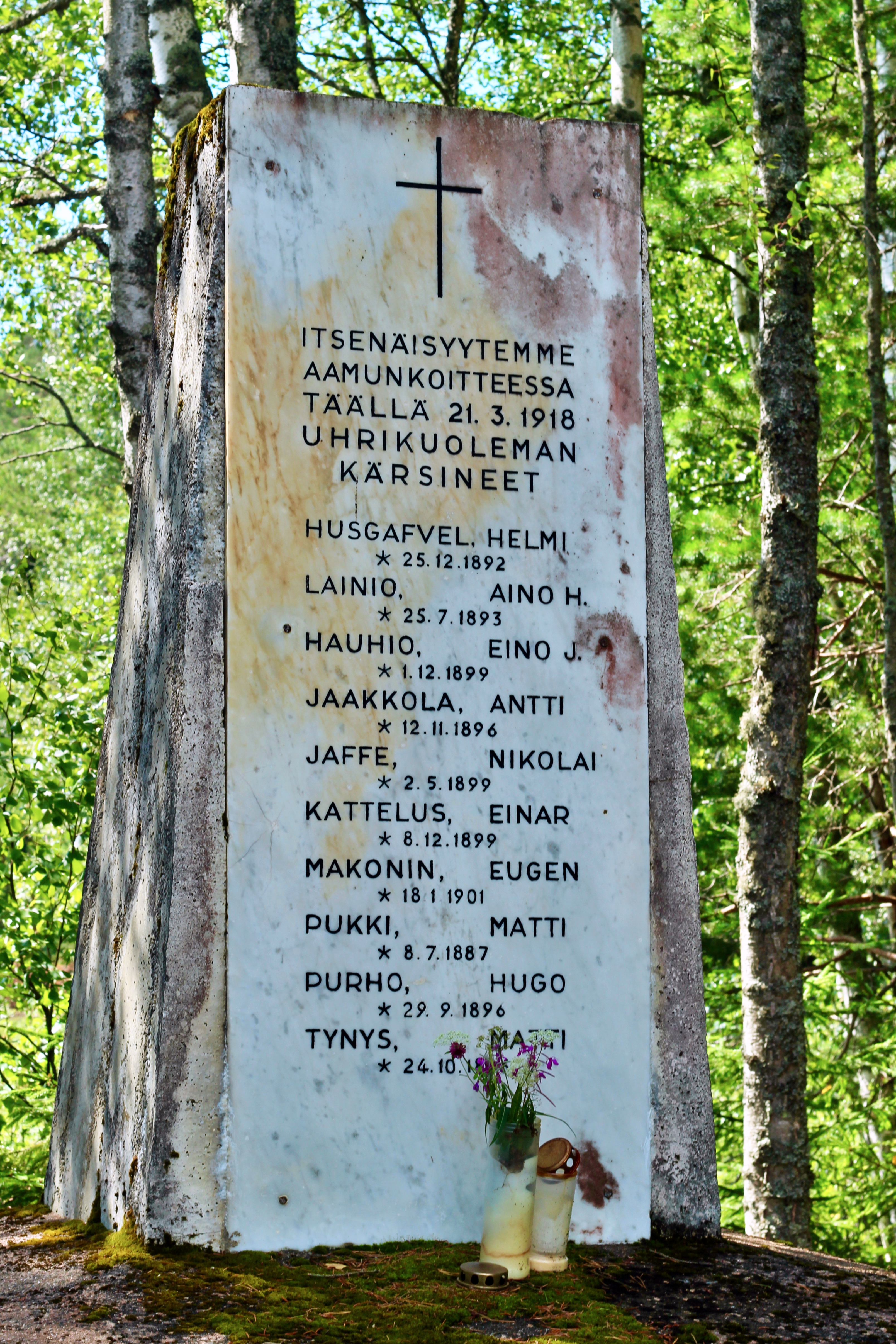
Lauri Pelkonen
Lauri Arvid Pelkonen oli suomalinen jääkäri. Hän syntyi maanviljeliä perheeseen 2.9.1894 Pyhjärvellä. Pelkonen kirjoitti ylioppilaaksi Käkisalmen yhteiskoulusta vuonna 1913 ja liittyi Karjalaiseen osakuntaan. Opintojaan hän jatkoi Kauppakorkeakoulussa vuosina 1913–1914. Ennen liitymistään vapaaehtoisena Saksassa sotilaskoulutusta antavan jääkäripataljoona 27:n pioneerikomppaniaan, 30. tammikuuta 1916, Pelkonen työskenteli kansakoulun opettejana (1914) ja rautatierakennustyömaalla kirjurina (1915). Lähtiessään Saksaan Pelkonen oli 21 vuotias ja naimaton.
Pelkonen otti osaa ensimmäisen maailmansodan taisteluihin Saksan itärintamalla muun muassa Misse-joella. Pataljoonan palattua rintamalta hänet siirettiin 2. konekiväärikompanjaan 10.7.1917. Vuonna 1917 Pelkonen osallistui myös Polangenissa järjestetyille hävitystekniikkaan painoittuneelle erikoiskursseille, Pomarikursille.
Taavetin kahakka
Usein eletään käsityksessä, että sisällisota alkoi 27-28.1. välisenä yönä vuonna 1918, kun "punaiset" nostivat punaisen lyhdyn Helsingin työväentalon torniin. Se ei kuitenkaan ole koko totuus. Etekin Karjalassa käytiin taisteluita ennen varsinaisen sodan syttymistä. Nämä taistelut keskityivät pitkälti Viipurin hallussa pitoon sekä asevarusteluun.
Luumäen suojeluskunta ei saanut tarvittavia aseita Viipurista. Päteetiin hankkia aseita tuhoamalla ja tyhjentämällä Mikkeliin matkalla ollut junnanvaunu, joka oli täynnä "punaisten" aseita. Kaappaussuoritetiin reilua viikoa ennen varsinaisen sodan alkamista, 19.1. Alunperin asevaunua koetetiin tuhota SImolan asemalla, mutta sen onnistui jatkaa matkaansa Taavetin asemalle, jossa suojeluskuntalaiset onnistuvat irroittamaan osin poltetun vaunun junasta. Aseet haudattiin läheiseen hiekkakuoppaan, sillä hevosia ei ollut riittävsti niiden poisviemiseksi.
Tieto asekaappauksesta kiiri nopeasti Viipurin "punaisten" joukkoon. Lappeerantaa tuli välittömästi käsky, noutaa aseet äkkiä takaisin. Noin 200 punaista kuljettava juna lähti matakalle Luumäelle. Junan maka pysähtyi ennen Taavetin asemaa, sillä suojeluskuntalaiset Lauri Pelkosen käskystä olivat tuhonneet raiteet ja näin estivät junaa jatkmasta matkaansa aina Tavaettiin saakka.
Pelkonen saapui Luumäen suojeluskunnnana johtajaksi Kouvolasta. Osa miehistä piteli ensikertaa asetta kädessään, joten kokenutta johtoa kaivatiin. Pelkonen asettin miehensä (n.20) asemiin Taavetin Linnoituksen valleille odoittaamaan "punaisten" saapumista.
Punaiset vaelsivat yön pimeydessä kohti Taavettiin asemaa. He pelkäsivät väijytystä ja ampuivat sekasorrossa omiaan. Aamun valjetessa "punaiset" saapuivat Taavetiin. Osa heistä lähti notamana lääkäriä hoitamana haavoittuneita. Nämä mieht Pelkonen joukkouneen onnistui kuitenkin ottamaan vangiksi.
Kohta "punaiset" lähestyivät Pelkosen joukon asemia. Tulitaistelu syttyi. "Punaiset" maastoutuivat ja Pelkonen antoi käskyn sulkea tulen. Sitten hän nousi tielle ja heitti käsikranaatin kohti "punaisten" joukkoja. Samassa "punaisten" luodit lävistivät miehen rinnnan.
Illan suussa "punaiset" perääntyivät takaisin Lappeenrantaan kuulessaan huhun lähestyvistä "valkoisten" vahvistusjoukoista. Todellisuudessa kyse oli vain 40 mihen ryhmästä, mutta taistelu Taavetissa oli tullut päätökseen ja Pelkosen nimi jäi historiiaan ensimmäisenä Suomessa kaatuneena jääkärinä.
Muistomerkki
Pelkosen muistoksi pystytetiin miehen kuolin paikalle 15 vuottakaatumisen jälkeen, 20.1.1933, muistomerkki. Paikalla oli runsaasti suojeluskuntalaisia kunnioittamassa edesmenneen päälikkönsä muistoa. Alunperin muistomerkin ympärillä oli rauta-aita, minkä oviaukossa oli Karjalan vaakunatunnus ja vuosiluku 1918. Aita on sittenmmin postettu ja muistomerkki siiretty tien varteen. Nykysin se sijaitsee Marttilan- ja Jääkärinteiden risteyksessä.
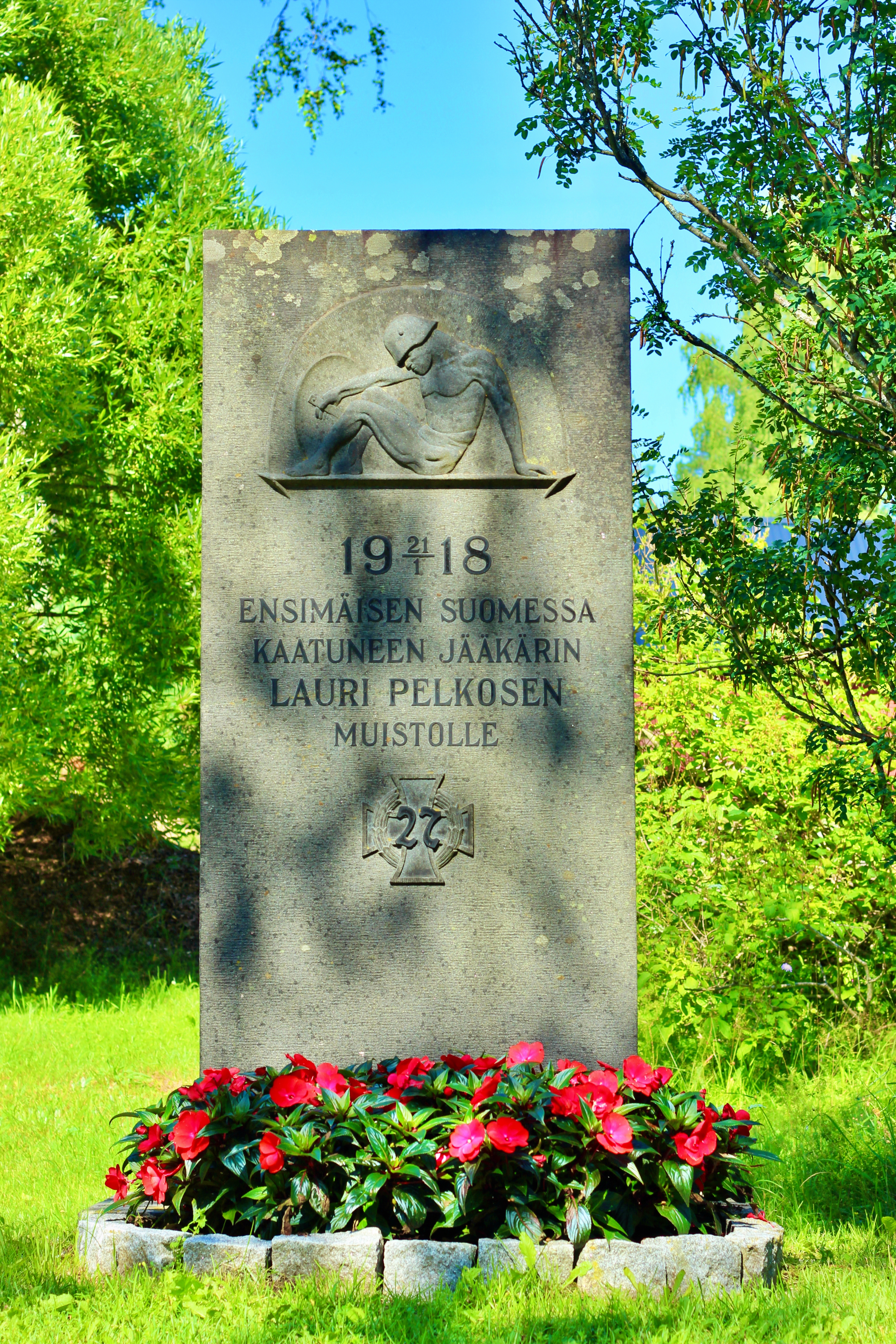
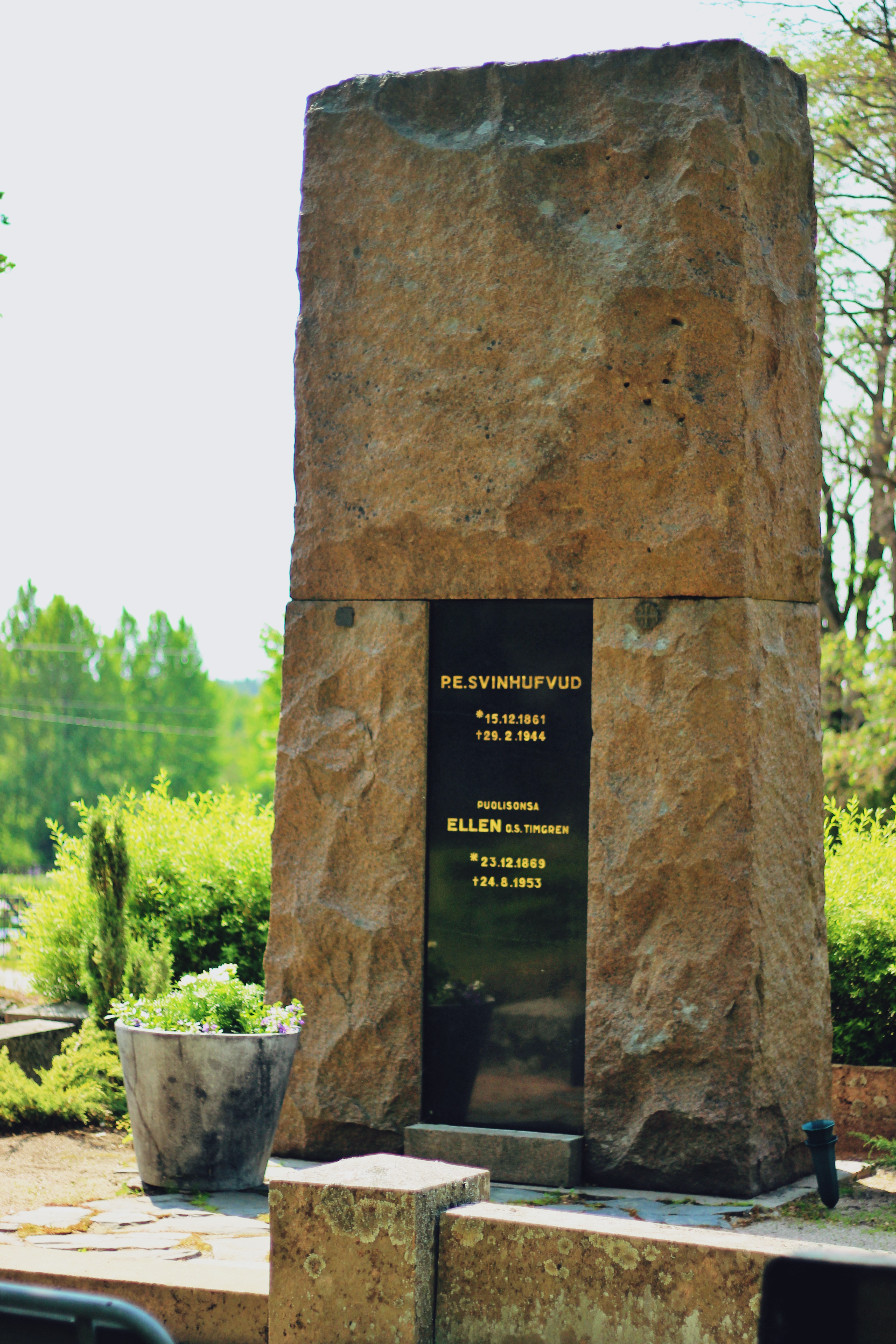
Muistomerkki sijaitsee Luumäen Kirkonmäellä hautausmaalla.
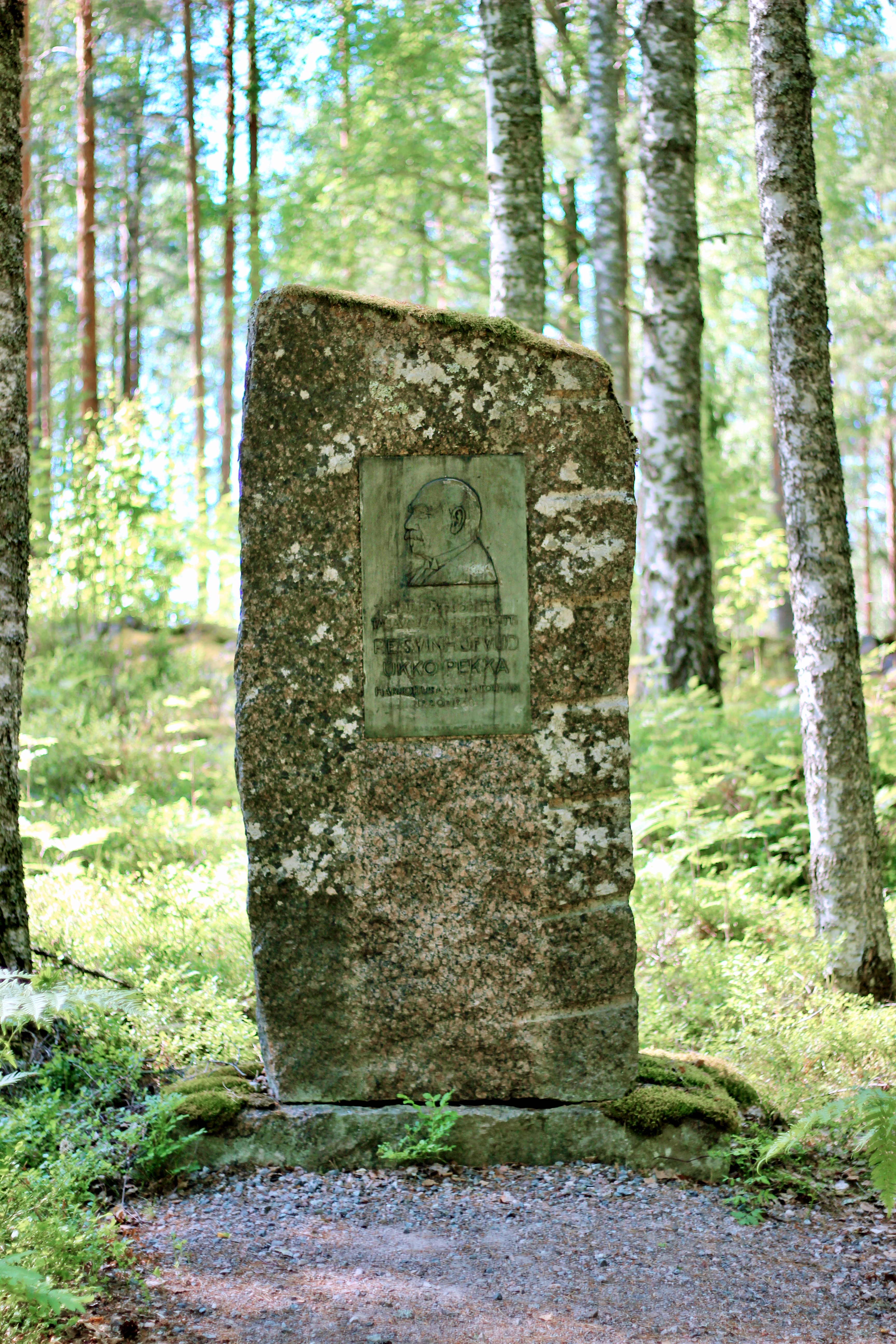
Innokkaana ampujana Svinhufvudilla oli oma ampumarata Kotonaan Kotkaniemessä. Ampumarata sijaitsi niemen metsäiselll alueella. Ampumaharjoituksia varten oli tehty rata kiväärille, pienoiskiväärille sekä pienipistoolirata. Svinhufvud ei kuitenkaan erityisesti raivannut aluetta ampumarataa varten vaan hyödynsi alueella luonnostaan olevia aukkoja. Hän halusispitää metsänsä mahdllisimman kuonnonmukaisina. Radalle emntäessä ripustetiin kylti "Sei! Rannalla ammutaan!", jotta muut osasivat varoa.
Karjalan Ampujapiiri pystytti ampumaradan viereen muistokiven vuonna 1963. Tällä hetkellä muistomerkkiä pääseen helposti ihastelemaan Kotkaniemen luontopolun varrella osoitteessa Itsenäisyydentie 799 a.
Jalaväkirykmentti 5 "Aaverykmentti"
Rykmenttiperustettiin keäskuussa 1941 Luumäellä 5PR:sta aj reserviläisistä. Rykmentti sai nimen "Aaverykmentti" naapurijoukoosastojen miehiltä. Varusmiesrykmenttiä käytettiin kenties muita enemmin pitkiin ja vaivalloisiin korpikoukkauksiin. Sen ilmestyminen aaveen lailla vihollisenselustaa saattoi joskus helpottaa naapurijoukkoosastojen tilannetta.
os. Linnalantie 33, Kunnantalon etupihalla
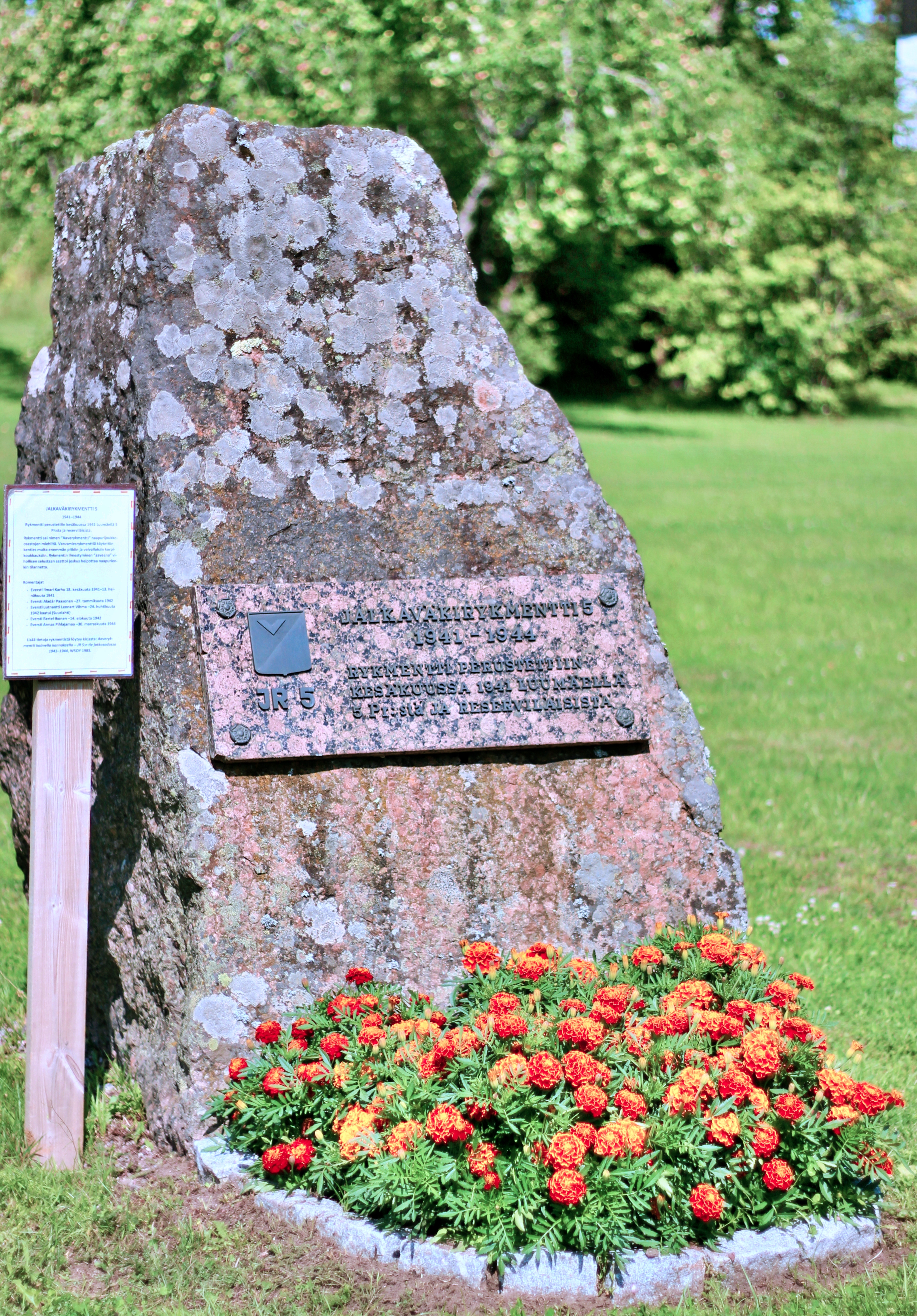
Jalkaväkirykmentti 200 "Suomen vapauden ja Viron kunnian puolesta"
Virolaistykmentti perustetiin Luumäellä helmikuussa 1944, ja kesällä 1944 rykmentti puollusti SUomea suurtaisteluissa Knannaksella. Tämä vapaaehtoinen rykmentti oli yli puolivuotta puolustusvoimiemme joukko-osasto. Pääosa koulutettiin taavetissa ja siksi muistomerkki on sijoitettu sinne (Kunannatalon etupihalla os. Linnalantie33)
Useimoia vapaaehtoisia odotti kotiinpaluun jälkeen kova kohtalo: rangaistukset olivat lyhyimmilläänkin 10 vuotta pakkotyötä Neuvostoliiton vankileirillä. Moniene kohdalla 25 vuotta tai jopa ylikin.
Muistomerkki on valmistettu kahdesta Salpalinjan panssariestekivestä, joissa on teksti: "Soome vabaduse ja Eesti au eest" sekä "Suomen vapauden ja Viron kunnian puolesta". Muistomerkki paljastetiin 18.8.1991. Hankkeen takana olivat Sotaveteraani- ja reserviläisjärjestöt.
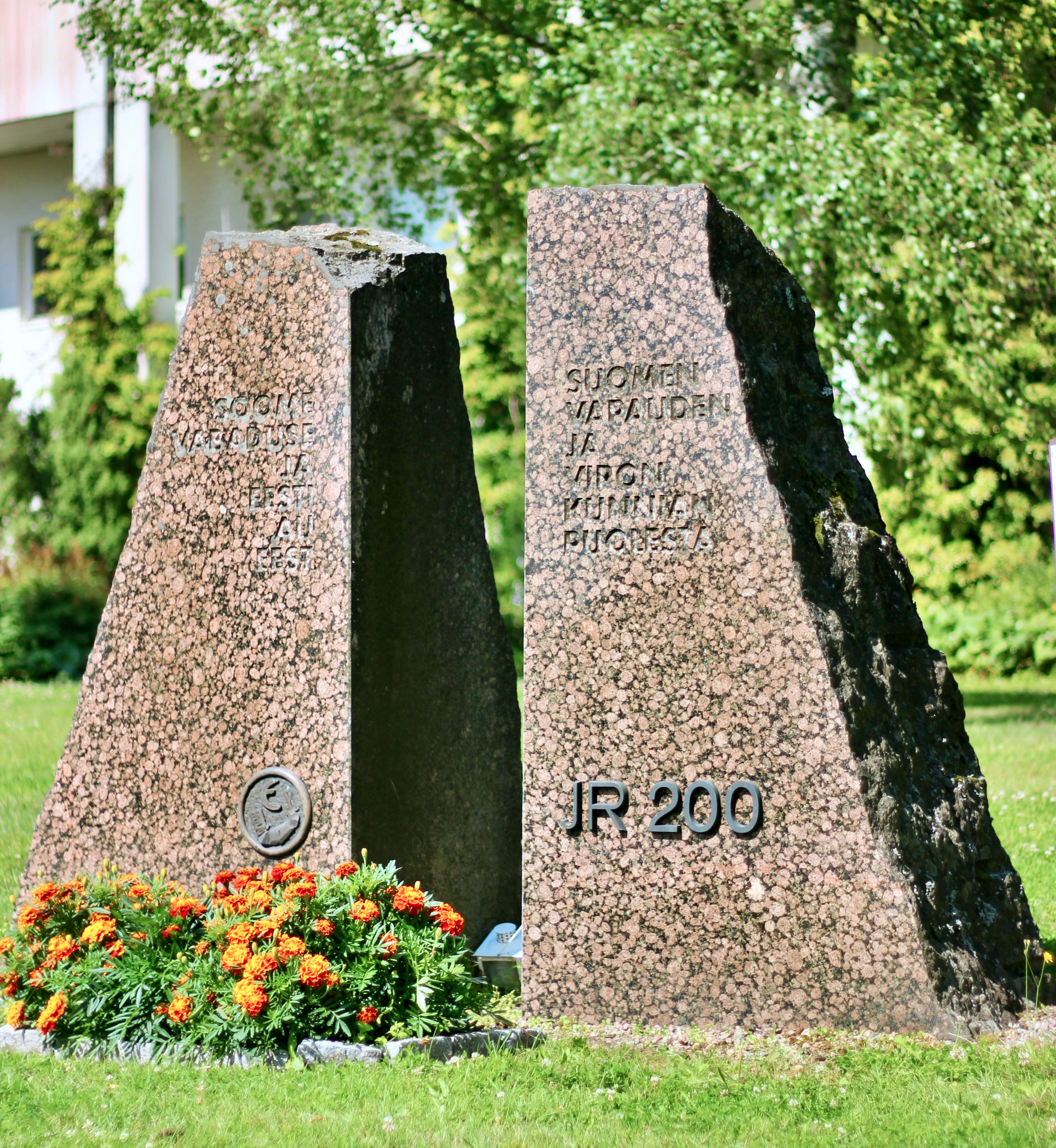
Monument to the last battle of the Finnish civil war
The Finnish civil war, or war of independence, was fought from January 27 to May 15, 1918, immediately after Finland's independence. The political changes that took place in Russia, the collapse of tsarist rule and World War I enabled Finland to become independent at the end of the previous year. However, the unstable situation caused a political and military crisis that led to the war in January 1918. The forces of the reds ruled southern Finland, the more northern Finland was ruled by the whites. The fighting that led to the settlement of the war was fought in March and April 1918. At that time, white troops occupied the big cities of southern Finland together with the Germans. More than 37,000 people died in the war, only some of them died on the front, some in other violence and some in prison camps.
It has been told that the first and last battles of the war took place in Luumäki. The first battle was fought before the actual start of the civil war on January 21st. A few days earlier, the white troops of Luumäki had hijacked the transport of the red troops and captured about 70 rifles and 10,000 rounds. The red guard of more than two hundred men left Lappeenranta by train to Taavetti to get those weapons back. One person died in the resulting battle. The situation ended with the retreat of the reds as rumors of thousands of the whites approaching the reds. Lauri Pelkonen, a Jaeger who fought in the whites, died in that battle, and a monument has been erected to him at the scene of his death.
By mid-February, the entire parish was in power with the reds. Their main task was to secure the traffic on the railway and the area remained an important behind-the-scenes maintenance area. Occasional riots arose when people going to the front of the whites passed through Luumäki or attempted to sabotage railway transports. It was not until April that the situation changed when the whites attack on Vyborg began.
One of the last battles of the War of Independence was fought between whites and reds in Kiurula on May 1, 1918. At the beginning of the occupation of Vyborg, the fronts of the reds were already partly scattered, and they retreated towards the Kymenlaakso in the western part of South Karelia. The loss of Pulsa's station caused the reds to relinquish their position in Luumäki and move west to the church areas. Whites’ cannons fired from the house of the Kangasvarsi youth club and red ones from the direction of the church hill for two days until the location of the red artillery stations was revealed and the situation was resolved for the red to retreat. The fighting continued in the Taavetti area the next day.
The Luumäki conservatory erected a monument on the site of the last battle in the 1930s. The monument is right along the Itsenäisyydentie road in Kiurula. The whites’ tomb of the civil war is located on Luumäki church hill. The tomb of the reds who died because of their beliefs is in Taavetti’s cemetery.
Link to the monument in Google Maps.
Monument to the legal battle
A granite statue has been erected as a sign of the legal battle against the repression that took place during the end of Russian rule. It is made not only to commemorate the events experienced by President P.E. Svinhufvud, but to commemorate the struggle for justice of the whole nation of Finland. The battle ended with Finland 's independence in 1917.
The initiative to establish the monument was born in the Luumäki Homeland and Museum Association in the mid-1930s. The original idea was to renovate Luumäki's old town hall, from which the then district judge P.E. Svinhufvud was sought from the councils deemed illegal by the ruler. He was imprisoned and deported to Siberia for a couple of years in November 1914. However, the renovation of the building did not take place, and a statue was purchased for Luumäki station.
A closed invitation competition was held for the design of the monument in the summer of 1937, which was won by sculptor Wäinö Aaltonen with a sketch of a triangular statue. There was a rush to make the statue, as it was supposed to be unveiled on the eve of the twentieth Independence Day. The statue was designed by Kiviveistämö Oy Forsman from Helsinki together with Wäinö Aaltonen. The delivery included the manufacture, foundations and erection of the monument. The statue was put in place just before the festivities on 30th of November. The monument is 7 meters high, and its sides are 1.5 meters wide, and it is made of reddish granite from Vehmaa.
The monument was solemnly unveiled on 5th of December. A valuable group of invited guests led by P.E. Svinhufvud and a couple of thousand spectators had arrived. After the unveiling, a festive dinner was held at the nearby Kangasvarsi school, as well as an evening party at the youth observatory.
The monument is not in its original location as it was moved in 2009 14 meters due to the expansion of the yard and the construction of an additional track. In 2017, a new alignment of Highway 6 was completed, and the monument is left on a narrow swathe east of the station building between the railway and the highway. It can be seen at a glance as you drive down the road. There is a passage to the monument through the Itsenäisyydentie road. At Jurvala Sale, turn south onto Suoanttila road and there are signs before the railway.
Link to the monument in Google Maps.
Monument of the Infantry Regiment 16
In October 2019, a new monument to the Infantry Regiment 16 was erected in the village of Hietamies to tell about the fortification work in the Luumäki area at the end of 1939. The monument was erected by the Pajarin Poikien Perinneyhdistys Ry association together with the municipality of Luumäki and other local operators. In connection with the monument, there is a wooden military sculpture by Leo Venäläinen and an information board. There is also a spacious car park.
The Infantry Regiment 16 was founded in Tampere between 14 and 18 October 1939, mainly by reservists from Northern Häme. Infantry Regiment 16 was part of the 6th Division, which was placed in the reserve of the military base. The regiment was commanded by Lieutenant Colonel Aaro Pajari and had a strength of about 3,000 soldiers.
After its establishment, the regiment was transferred by train to Taavetti station. From there it initially stayed south of the railway in the Heimala-Luotola-Patolahti area. At the turn of October and December, the regiment marched to the northern side of the railway and settled in the area between Lake Kivijärvi and the Village of Hietamies and started fortification work. The main emphasis in the fortification work was on the construction of armored barriers. In addition, stations were built on the roads, including machine gun stations and shooting ranges and battle grave fragments. There was about a third of the regiment in the fortification work every day, while the rest were in various training and rehearsal events.
After the start of the Winter War, the regiment received an order on December 5th to transfer by rail from Kaitjärvi and Taavetti stations to Värtsilä and from there onwards to direct combat battles as part of Department Talvela to Tolvajärvi.
The Huopaisenvirta monument
Huopaisenvirta and the monument are in many ways part of the history of Luumäki. The Väliväylä log floating route passed through Huopaisenvirta for about 70 years. The new bridge and the dam built at the mouth of the stream, as well as the lowering of the water surface of Lake Kivijärvi, have changed the landscape. The monument on the scene reminds us of the events of the early days of independent Finland a hundred years ago.
Väliväylä log floating route
The Väliväylä log floating route which passed through Huopaisenvirta is part of Finnish forest industry history. The Väliväylä floating route was opened for the transport of logs in the 1890s, and the 110 kilometers long route was in use for about seven decades. At the mouth of the Huopaisenvirta, the trees arrived as ferries surrounded by booms. The loads arriving from Ylä-Kivijärvi could have more than 16,000 logs each. The two-kilometer-long Huopaisenvirta was one of the problem areas of Väliväylä. The river was so narrow that it could not carry ferries, but on the other hand it was too wide that the flow did not carry trees properly. The height difference at Huopaisenvirta at that time was just over 40 cm. The rafts were demolished at the mouth of the Huopaisevirta and the trees were released into the stream. The trees were driven forward in the stream by booms that were attached to steel wires. At a narrow point in the stream, the flow was sufficient to transport the logs. Control booms were built on the sides of the stream to prevent the trees from getting stuck on the shores.
The flooding ended at the early 1960s because of the decline of the Kivijärvi water surface. Huopaisenvirta was dredged and a new bridge and regulation dam were built at the mouth of the stream. The water surface of Kivijärvi was lowered by more than 60 cm and the flow was considerably reduced. The floating structures have been demolished and the white-headed bubbling rapids during the spring floods are only living in the memories.
The log floating route was also used as a water barrier and fortification work was carried out north of the flouting route during the last wars. The fortification works in the watershed have been overshadowed by the more robust Salpaline and have not been fully mapped. Stone barriers and various trenches have been preserved best in the vicinity of the Väliväylä. The structures supported by the trees have rotted.
Monument
The Huopaisenvirta monument has been erected to commemorate the events of the 1918 Civil War. Luumäki was in the possession of the Reds for most of the war because of an important railway connection. During the war, dozens of refugees from the coast to the northern and White fronts passed through Luumäki. In March, a group of young people from Hamina were working towards the Whites and they were imprisoned in Luumäki. In the morning, the prisoners were transported on two sleighs to Savitaipale for investigation. Along the way, prisoners, two women and eight men, were shot. Some of the deceased were thrown into the river from the Huopaisenvirta bridge.

